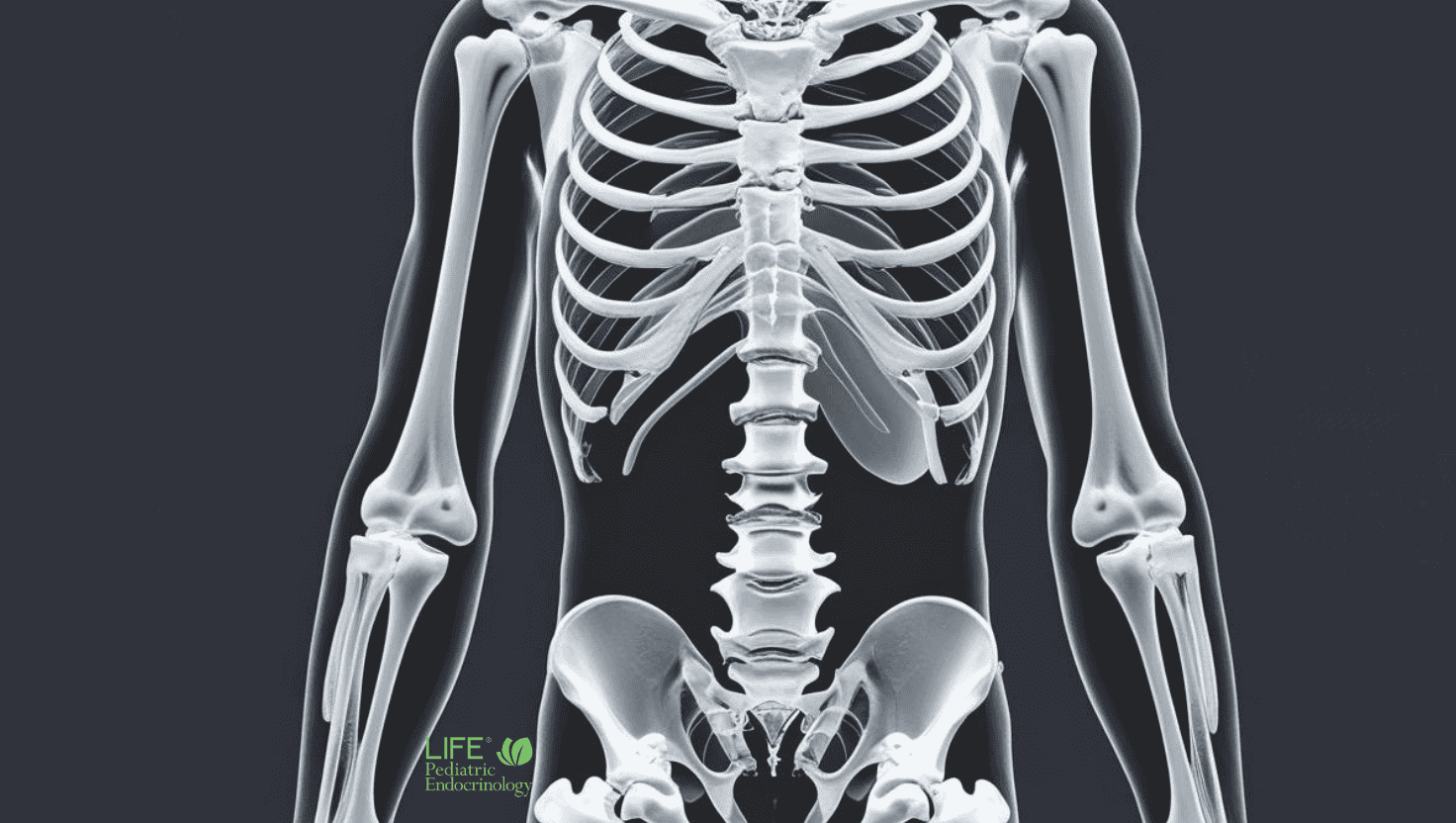A complete guide to osteogenesis imperfecta (OI): diagnosis, symptoms, and expert care for children with brittle bones
By Dr. Kelli Davis, Pediatric Endocrinologist & National Expert in Bone Health
Introduction
Osteogenesis imperfecta (OI), often called “brittle bone disease,” is a rare inherited connective tissue disorder that causes bones to break easily—sometimes with little or no trauma. Families often first recognize the condition after multiple unexplained fractures in a child. At Life Pediatric Endocrinology, our team specializes in diagnosing and treating complex bone disorders like OI, helping children live healthier, more confident lives.
Causes of Osteogenesis Imperfecta
The majority of OI cases (about 80–90%) are caused by mutations in the COL1A1 or COL1A2 genes, which are responsible for producing type I collagen—the main protein that gives bone its structure and strength. These mutations can be inherited in an autosomal dominant pattern, though many cases occur due to new (de novo) mutations without a family history.
Less common forms of OI may be inherited in autosomal recessive or X-linked patterns, often involving genes that affect collagen processing or osteoblast (bone-building cell) function.
Symptoms and Clinical Features
OI affects more than just bones. While bone fragility is the hallmark, children and adults with OI may experience:
-
Frequent fractures from minor trauma
-
Short stature or growth deficiency
-
Blue sclerae (a bluish tint in the whites of the eyes)
-
Dentinogenesis imperfecta (weak, discolored teeth)
-
Hearing loss in adolescence or adulthood
-
Scoliosis and other spinal deformities
-
Joint hypermobility
-
In severe cases, skeletal deformities and cardiopulmonary complications
Because OI is highly variable—even within the same family—some individuals have only mild symptoms, while others face significant medical challenges.
Diagnosis of Osteogenesis Imperfecta
Accurate diagnosis is critical for proper treatment. The American Academy of Pediatrics (AAP) emphasizes that OI should always be considered in cases of unexplained fractures in children.
Diagnosis is based on:
-
Clinical history (fracture frequency and family history)
-
Radiographic imaging (showing fracture patterns and bone structure)
-
Genetic testing (confirmation of collagen-related mutations)
Treatment and Management Strategies
There is no cure for OI, but treatment focuses on reducing fracture risk, improving mobility, and enhancing quality of life.
Medical Management
-
Bisphosphonates are the mainstay of therapy in children, helping strengthen bones, reduce fracture risk, and improve vertebral shape.
-
Emerging therapies are being studied, including medications targeting bone formation and gene-directed therapies.
Supportive Care
-
Physical therapy to build muscle strength and support joint stability
-
Orthopedic care for fracture repair and correction of deformities
-
Dental care for dentinogenesis imperfecta
-
Hearing assessments in older children and adults
Multidisciplinary Approach
At LIFE, we emphasize a team-based model—pediatric endocrinologists, orthopedic surgeons, geneticists, and physical therapists work together to give each child a personalized treatment plan.
Long-Term Outlook
With proper diagnosis and management, many children with OI lead fulfilling and active lives. Advances in bone therapies continue to improve outcomes, and ongoing research offers hope for even more effective treatments in the future.
Related Resources on Bone Disease at LIFE
Want to learn more about rare and common bone conditions? Explore our other expert-written resources:
When to See a Pediatric Endocrinologist
If your child has experienced multiple fractures, poor growth, or other symptoms of bone fragility, it’s important to seek expert evaluation. At LIFE Pediatric Endocrinology, we are nationally recognized for our integrative approach to bone health.
👉 Click here to request a consultation with Dr. Kelli Davis and our team.
Frequently Asked Questions (FAQ)
What is osteogenesis imperfecta (OI)?
Osteogenesis imperfecta is a genetic bone disorder, often called brittle bone disease, where fragile bones break easily due to problems with collagen.
Is brittle bone disease the same as osteogenesis imperfecta?
Yes. Brittle bone disease is the common name for osteogenesis imperfecta, a condition caused by genetic mutations that affect bone strength.
What are the symptoms of osteogenesis imperfecta in children?
Symptoms include frequent fractures, short stature, blue sclerae (bluish whites of the eyes), dental problems, hearing loss, and joint hypermobility.
Can osteogenesis imperfecta be cured?
There is no cure for OI, but treatments like bisphosphonates, physical therapy, and specialized care can reduce fractures and improve mobility.
How is osteogenesis imperfecta diagnosed?
Diagnosis is based on clinical history, X-rays, and genetic testing to confirm mutations in collagen-related genes.
When should I see a pediatric endocrinologist for OI?
If your child has multiple fractures or signs of bone fragility, a pediatric endocrinologist can help confirm the diagnosis and coordinate care.
References
-
Haney S, Scherl S, DiMeglio L, et al. American Academy of Pediatrics. AAP Clinical Report on OI
-
Arshad F, Bishop N. Bone. 2021. PubMed 33722772
-
Trejo P, Rauch F. Osteoporosis Int. 2016. PubMed 27492436
-
Marini JC, Forlino A, Bächinger HP, et al. Nat Rev Dis Primers. 2017. PubMed 28820180
-
Rossi V, Lee B, Marom R. Curr Opin Pediatr. 2019. PubMed 31693577
Share this
You May Also Like
These Related Stories

What Is Bone Disease? Understanding Causes, Symptoms, and Treatments

What Are The Symptoms of Bone Disease?


